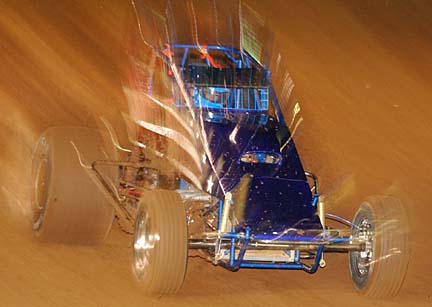
RONEN ZILBERMAN / RZILBERMAN@STARBULLETIN.COM
A driver took his sprint car out on the dirt track of Hawaii Motor Speedway last night.
Sprint cars are here
The United States Auto Club has prided itself on being the outlet for drivers who truly love the sport.
And to prove it, USAC officials have come to Hawaii to get a taste of what this state's drivers do to profess their love for the automobile.
The USAC Southwest Sprint Series brought 12 of its best drivers to town this week to take on 12 of Hawaii's best tomorrow and Saturday nights at Hawaii Motor Speedway. It is billed as the Southwest's best against Hawaii's best, but the groups couldn't be more different. Or more the same.
USAC drivers generally race for between $1,000 and $2,000 for the winner, while Hawaii's drivers show up every week and bounce $30,000 machines off each other for a payoff of around $350, or the price of a set of tires and a tank of gasoline.
"You have to love the sport," local favorite Dean Freitas said. "There is no other reason why we would do this."
But this time, their love of the sport pays off. Tomorrow's winner of the Sprint Car Classic will take home $1,200 and Saturday's fastest will get $1,500.
Few drivers in the country make money on a race track, so the mainland drivers will be looking to get back the money they spent getting here, while Hawaii's drivers may actually make a buck before spending it all on their cars.
But like the drivers, those who show up to watch 24 sprint cars jammed onto a quarter-mile track care little about the money at stake. They want to know who will win.
Freitas is billed as Hawaii's best shot along with Gary Costa and the Ternora brothers. The Southwest Series is counting on regionally recognizable names like Rick Ziehl and Mike Boat.
The only way to find out for sure is to wait until after the event. Both sides have all the reasons in the world to believe that their side is at a huge disadvantage.
Hawaii's drivers have knowledge of the track, a full toolbox and a hometown crowd on their side. The USAC drivers have knowledge of the type of racing and experience with thinking on their feet.
All 24 drivers took a practice run on the track last night, pretty much erasing any advantage Hawaii had there.
The USAC Southwest Series is run on 10 different tracks without the benefit of practice. Last night was a bonus for them.
"We get kind of a head start this time," said Boat, who was the series champion last year. "Usually we just show up and stare at the track then hit it. I know the locals didn't want us out there."
What they learned is that Hawaii's track is not what it seems and to show up and race without testing it would have been trouble.
"It's a little early to tell because the track is still a little greasy," said USAC driver Mike Martin, who was among the first on the track last night. "But the corners are tight and the straight-aways are longer than they appear. You can definitely pick up some speed and shoot out of the corner."
Even with the newcomers on the track, it doesn't mean they are going to be stealing local knowledge. They might peek at Freitas to get a clue, but most of these professionals rely on their own skill to determine what the fastest line around the track will be. If those grooves converge, watch out.
The USAC Southwest Series runs with more powerful engines and without "wings," or giant spoilers mounted on the hoods of their cars. Those wings, which most of Hawaii's drivers use, make handling the car completely different.
"You can power and control the race car with the wing; without the wing it is like a stray bullet," Freitas said. "I don't know how many of us will make it to Saturday."
As the sponsor, Pacific Air Cargo flew 12 cars, 70 tires and 30 55-gallon drums of methanol alcohol to the state, but the drivers had to pick and choose what spare parts they wanted to bring since they usually fill a semi-truck trailer on race day.
"We were really limited on what we could bring over here," Martin said. "I don't think any one of us has the parts to completely rebuild a car, but we can all borrow from each other. Engine parts are non-existent. If the wrong part breaks during practice, we are done."
Even with the advantages and disadvantages both sides claim, they can agree that most of the time it comes down to who drives the car best.
"If I could go and pick a local car, I wouldn't count myself out," Boat said. "There is a horsepower advantage for us, but it is not that much of one. With the wings, the car steers itself. Without the wings, it comes down to knowledge, setup and skill."
That is not to say that Boat and his counterparts are looking past Hawaii's shade-tree mechanics.
"They are the underdogs, but this is their home track," Boat said. "Where we come from we are the underdog, so we know that to underestimate them would be a big mistake."
